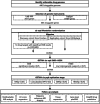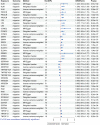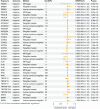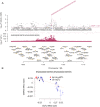Multi-omics Mendelian randomization integrating GWAS, eQTL and pQTL data revealed GSTM4 as a potential drug target for migraine
- PMID: 39039470
- PMCID: PMC11265128
- DOI: 10.1186/s10194-024-01828-w
Multi-omics Mendelian randomization integrating GWAS, eQTL and pQTL data revealed GSTM4 as a potential drug target for migraine
Abstract
Introduction: Migraine, as a complex neurological disease, brings heavy burden to patients and society. Despite the availability of established therapies, existing medications have limited efficacy. Thus, we aimed to find the drug targets that improve the prognosis of migraine.
Method: We used Mendelian Randomization (MR) and Summary-data-based MR (SMR) analyses to study possible drug targets of migraine by summary statistics from FinnGen cohorts (nCase = 44,616, nControl = 367,565), with further replication in UK Biobank (nCase = 26,052, nControl = 487,214). Genetic instruments were obtained from eQTLGen and UKB-PPP to verify the drug targets at the gene expression and protein levels. The additional analyses including Bayesian co-localization, the heterogeneity in dependent instruments(HEIDI), Linkage Disequilibrium Score(LDSC), bidirectional MR, multivariate MR(MVMR), heterogeneity test, horizontal pleiotropy test, and Steiger filtering were implemented to consolidate the findings further. Lastly, drug prediction analysis and phenome-wide association study(PheWAS) were employed to imply the possibility of drug targets for future clinical applications.
Result: The MR analysis of eQTL data showed that four drug targets (PROCR, GSTM4, SLC4A1, and TNFRSF10A) were significantly associated with migraine risk in both the FinnGen and UK Biobank cohorts. However, only GSTM4 exhibited consistent effect directions across the two outcomes(Discovery cohort: OR(95%CI) = 0.94(0.93-0.96); p = 2.70e - 10; Replication cohort: OR(95%CI) = 0.93(0.91-0.94); p = 4.21e - 17). Furthermore, GSTM4 passed the SMR at p < 0.05 and HEIDI test at p > 0.05 at both the gene expression and protein levels. The protein-level MR analysis revealed a strong correlation between genetically predicted GSTM4 with a lower incidence of migraine and its subtypes(Overall migraine: OR(95%CI) = 0.91(0.87-0.95); p = 6.98e-05; Migraine with aura(MA): OR(95%CI) = 0.90(0.85-0.96); p = 2.54e-03; Migraine without aura(MO): OR(95%CI) = 0.90(0.83-0.96); p = 2.87e-03), indicating a strong co-localization relationship (PPH4 = 0.86). Further analyses provided additional validation for the possibility of GSTM4 as a migraine treatment target.
Conclusion: This study identifies GSTM4 as a potential druggable gene and promising therapeutic target for migraine.
Keywords: Colocalization analyses; Drug target; GSTM4; Mendelian randomization; Migraine; Summary-data-based MR.
© 2024. The Author(s).
Conflict of interest statement
The authors declare no competing interests.
Figures












References
-
- GBD 2016 Disease and Injury Incidence and Prevalence, Collaborators (2017) Global, regional, and national incidence, prevalence, and years lived with disability for 328 diseases and injuries for 195 countries, 1990–2016: a systematic analysis for the global burden of Disease Study 2016. Lancet 390(10100):1211–1259 10.1016/S0140-6736(17)32154-2 - DOI - PMC - PubMed
MeSH terms
Substances
LinkOut - more resources
Full Text Sources
Medical
Miscellaneous

